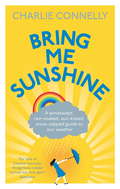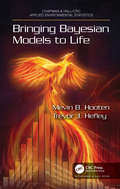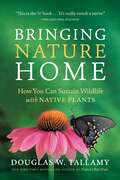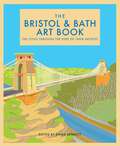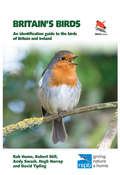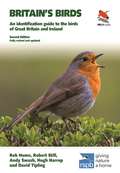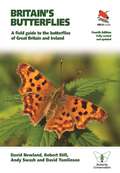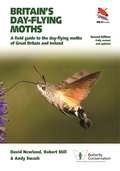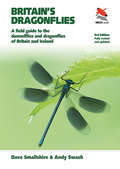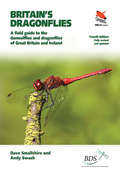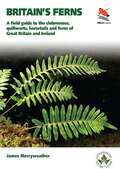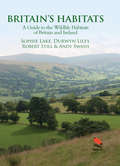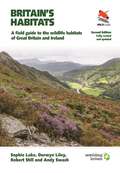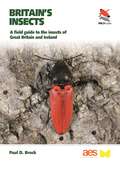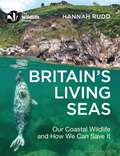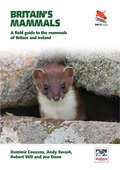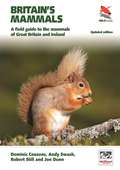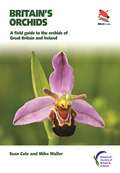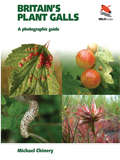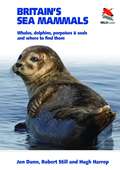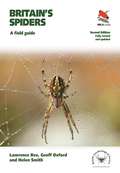- Table View
- List View
Bring Me Sunshine: A Windswept, Rain-Soaked, Sun-Kissed, Snow-Capped Guide To Our Weather
by Charlie ConnellyWe talk about the weather a lot. It exasperates, confounds and on occasion delights us. Our national conversation is dominated by the weather, but how much do we really know about it? In Bring Me Sunshine, Charlie Connelly sets off on the trail of our island obsession. He breezes through the lives of meteorological eccentrics, geniuses, rainmakers and cloud-busters and brings vividly to life great weather events from history. He sheds light on Britain's weirdest wind, why we have the wettest place in England to thank for the trusty pencil, the debt that umbrella owners owe to Robinson Crusoe and why people once thought firing cannons at clouds was a great idea. Having adventured round the shipping forecast areas for his bestselling Attention All Shipping, Connelly is the perfect guide through a mélange of gales, blizzards, mists, heatwaves and the occasional shower of fish. By turns informative, entertaining and hilarious, Bring Me Sunshine answers all your weather questions as well as helping you to distinguish your graupel from your petrichor.
Bring on the Apocalypse: Six Arguments for Global Justice
by George Monbiot'A dazzling command of science and a relentless faith in people... I never miss reading him.' -- Naomi KleinIn these incendiary essays, George Monbiot tears apart the fictions of religious conservatives, the claims of those who deny global warming and the lies of the governments and newspapers that led us into war. He takes no prisoners, exposing government corruption in devastating detail while clashing with people as diverse as Bob Geldof, Ann Widdecombe and David Bellamy. But alongside his investigative journalism, Monbiot's book contains some remarkable essays about what it means to be human. Monbiot explores the politics behind Constable's The Cornfield, shows how driving cars has changed the way we think and argues that eternal death is a happier prospect than eternal life.
Bring The Outside In: The Essential Guide to Cacti, Succulents, Planters and Terrariums
by Val BradleyTHE PERFECT GIFT FOR BEGINNERS"Everything you need to know about keeping plants in your house... lovely pictures, tips, tricks... I love it." (Zoe Sugg a.k.a Zoella)Love plants, but short on outdoor space? Or feeling inspired by striking terrariums and succulent gardens? Keen to create a unique home brimming with greenery? Then this is the book for you. With stunning photography and expert step-by-step tips, Bring The Outside In reveals everything you need to know to help your plants thrive, from dramatic statement foliage and miniature citrus trees to table-top terrariums and hanging planters. With chapters on orchids, cacti, herb gardens and chilli plants, your home will be flourishing in no time.
Bringing Bayesian Models to Life (Chapman & Hall/CRC Applied Environmental Statistics)
by Mevin B. Hooten Trevor J. HefleyBringing Bayesian Models to Life empowers the reader to extend, enhance, and implement statistical models for ecological and environmental data analysis. We open the black box and show the reader how to connect modern statistical models to computer algorithms. These algorithms allow the user to fit models that answer their scientific questions without needing to rely on automated Bayesian software. We show how to handcraft statistical models that are useful in ecological and environmental science including: linear and generalized linear models, spatial and time series models, occupancy and capture-recapture models, animal movement models, spatio-temporal models, and integrated population-models. Features: R code implementing algorithms to fit Bayesian models using real and simulated data examples. A comprehensive review of statistical models commonly used in ecological and environmental science. Overview of Bayesian computational methods such as importance sampling, MCMC, and HMC. Derivations of the necessary components to construct statistical algorithms from scratch. Bringing Bayesian Models to Life contains a comprehensive treatment of models and associated algorithms for fitting the models to data. We provide detailed and annotated R code in each chapter and apply it to fit each model we present to either real or simulated data for instructional purposes. Our code shows how to create every result and figure in the book so that readers can use and modify it for their own analyses. We provide all code and data in an organized set of directories available at the authors' websites.
Bringing Bayesian Models to Life (Chapman & Hall/CRC Applied Environmental Statistics)
by Mevin B. Hooten Trevor J. HefleyBringing Bayesian Models to Life empowers the reader to extend, enhance, and implement statistical models for ecological and environmental data analysis. We open the black box and show the reader how to connect modern statistical models to computer algorithms. These algorithms allow the user to fit models that answer their scientific questions without needing to rely on automated Bayesian software. We show how to handcraft statistical models that are useful in ecological and environmental science including: linear and generalized linear models, spatial and time series models, occupancy and capture-recapture models, animal movement models, spatio-temporal models, and integrated population-models. Features: R code implementing algorithms to fit Bayesian models using real and simulated data examples. A comprehensive review of statistical models commonly used in ecological and environmental science. Overview of Bayesian computational methods such as importance sampling, MCMC, and HMC. Derivations of the necessary components to construct statistical algorithms from scratch. Bringing Bayesian Models to Life contains a comprehensive treatment of models and associated algorithms for fitting the models to data. We provide detailed and annotated R code in each chapter and apply it to fit each model we present to either real or simulated data for instructional purposes. Our code shows how to create every result and figure in the book so that readers can use and modify it for their own analyses. We provide all code and data in an organized set of directories available at the authors' websites.
Bringing Nature Home: How You Can Sustain Wildlife with Native Plants, Updated and Expanded
by Douglas W. TallamyNow with expanded content and plant lists for regional habitats, Bringing Nature Home offer the insight needed for home gardeners to become backyard ecologists.
The Bristol and Bath Art Book: The cities through the eyes of their artists (The city through the eyes of its artists)
by Emma BennettBristol and Bath are two beautiful, closely connected cities. They are portrayed through the eyes of their artists in a delightful variety of styles in this stunning book.The Bristol and Bath Art Book portrays two very different cities. The beautiful images in the book capture the breath-taking landscape of rivers, hills and gorges which they share, but also the cities' sights that are so unique. Bristol is painted as busy, quirky and vibrant, where Bath glows in more tranquil hues. These important cities in the history of the world are intimately connected.The river Avon that flows through both cities, gouges the spectacular Avon Gorge at Bristol, which is where its international maritime connections begin.The regenerated old docks (the 'floating harbour'), Wapping Wharf and the quayside are lovingly depicted by various artists. Now that the main docks are outside the city, the harbour-side now bustles with shops, bars and offices, but there are still cranes to be seen at the M shed. Underfall boatyard remains a home to maritime businesses and is also pictured in this lovely book, along with pleasure craft and houseboats in the harbour.John Cabot's The Matthew is the ship that put America on the map. The reconstruction is depicted in drawings and paintings. She may have been a pirate ship at one time, too, as Bristol was the birthplace of Blackbeard and had a thriving piracy business.From this Atlantic connection, the list of items traded expanded from wool, wine and grain to tobacco and alas, to slaves. The profits from this trade endowed many of the fine public monuments drawn and painted here. Like many places, Bristol is undertaking a new reckoning with its history.The great engineer Isambard Kingdom Brunel designed the Clifton Suspension Bridge to span the deep Avon Gorge. In the book, there are many images of this vertiginous bridge: ringed by balloons, luminous in the gloaming, stark in the snow, or painted to resemble a cathedral arch from below. It is a much-loved, living monument to the great man.His Great Western Railway terminus at Temple Meads features here in drawings and prints, along with his pioneering Bristol-built steamship, the SS Great Britain.Crossing Brunel's famous bridge over the Avon, you will find yourself in the tranquil Leigh woods, painted as a hotspot for bluebells in spring.The old Railway Path, flat, traffic-free and lined with greenery, takes you from Bristol to Bath, where you will find more gorgeous parks: the Georgian garden in the town centre, Alexandra Park with panoramas of the city and the Botanical Gardens with its aerial walkway.Bath is a UNESCO world heritage site because of its Roman remains and exquisite Georgian architecture. Its famous Roman Baths were built around a hot spring the Romans believed sacred to the Goddess Sulis and the city became a centre for health and an inspiration for artists.Its 18th-century architecture: The Royal Crescent, The Circus, Pulteney Bridge and Assembly Rooms, are all examples of Bath's heyday as a Georgian spa town and are featured in the art book in stunning paintings, drawings and collages.They capture the Bath that Jane Austen would have known from her time in the city. Here, movies of some of her novels have been filmed, along with many other Regency era series e.g. the record-breaking series Bridgerton.
Britain’s Birds: An Identification Guide to the Birds of Britain and Ireland (PDF)
by Rob Hume Robert Still Andy Swash Hugh Harrop David TiplingBritain's Birds will be enjoyed, valued and constantly referred to by all bird watchers—whether beginner, experienced or professional. This is the most comprehensive, up-to-date and practical bird book of modern times, featuring an unrivalled selection of photographs that show all the plumages you are likely to see. Focusing on identification, and containing maps, facts and figures on numbers and distributions, this breakthrough publication was devised by a team of lifelong birdwatchers, all with many years' experience of showing people birds and producing user-friendly field guides.Comprehensive coverage of every bird recorded in Britain and IrelandThe only photographic guide to show all plumages likely to be encounteredMore than 3,200 superb colour photographs carefully selected to show key identification featuresMany photographs of individual rare birds identified in Britain and IrelandSimple steps to help you find and identify any bird you seePages designed to allow easy and accurate comparisonLatest information on status, population, distribution and conservation designationsDistribution maps featuring summer, winter and resident ranges, plus details of migration routes to and from Britain and Ireland
Britain's Birds: An Identification Guide to the Birds of Great Britain and Ireland Second Edition, fully revised and updated (WILDGuides #41)
by Rob Hume Robert Still Andy Swash Hugh Harrop David TiplingA new, improved and thoroughly updated edition of the bestselling photographic guide—the only one to cover every bird, in every plumage, ever recorded in Britain and IrelandA bestselling guide since it was first published, Britain's Birds has quickly established itself as the go-to photographic identification guide to the birds of Great Britain and Ireland—the most comprehensive, up-to-date, practical and user-friendly book of its kind. Acclaimed by birdwatchers of all kinds, from the beginner to the most experienced, the guide has now been thoroughly revised and updated to make it even better than before. Combining the finest of identification guide content and presentation, this eagerly awaited second edition preserves the best of the first edition while covering twelve newly recorded species and offering a host of improvements that make identification easier.Provides comprehensive coverage of all the birds ever recorded in Britain and IrelandDescribes and illustrates all plumages likely to be encounteredFeatures more than 3,200 stunning photographs carefully selected to show the birds as you really see themOutlines simple steps to help you identify any bird you seePresents simple and accurate comparisons of similar and difficult speciesNew features include:Coverage of 12 new species recorded since the first edition plus revisions to reflect the latest taxonomyCoverage of all subspeciesImproved identification aids, including more than 400 new photos, enhanced photo annotations and many redesigned platesFully revised species accounts, including the latest information on identification features, status, numbers, geographical range and date ranges for all plumages that may be seen during only part of the year
Britain's Butterflies: A Field Guide to the Butterflies of Great Britain and Ireland – Fully Revised and Updated Fourth Edition (WILDGuides #75)
by David Newland Robert Still Andy Swash David TomlinsonA new and improved edition of the popular photographic field guideBritain’s Butterflies is a comprehensive and beautifully designed photographic field guide to the butterflies of Britain and Ireland. Containing hundreds of stunning colour photographs, this extensively revised and updated new edition provides the latest information on every species ever recorded. It covers in detail the identification of all 59 butterfly species that breed regularly, as well as four former breeders, 10 rare migrants and one species of unknown status. The easy-to-use format will enable butterfly watchers—beginners or experts—to identify any species they encounter. Produced in association with Butterfly Conservation, this edition features new introductory sections to the main "types" of butterflies; updated distribution maps; a revised species order reflecting the latest taxonomy; revised sections on recording and monitoring, and conservation and legislation; and a new section on climate change.Stunning colour plates show typical views of each butterfly species, including the various forms and common aberrationsDetailed species profiles provide information on status and distribution, including up-to-date maps, and cover adult identification; behaviour; breeding habitat requirements; population and conservation; egg, caterpillar and chrysalis; and caterpillar foodplantsPhotographs of the egg, caterpillar and chrysalis for every breeding speciesSections on biology, where to look for and how to identify butterflies, and other essential information
Britain's Day-flying Moths: A Field Guide to the Day-flying Moths of Great Britain and Ireland, Fully Revised and Updated Second Edition (WILDGuides #29)
by David Newland Robert Still Andy SwashA carefully designed and beautifully illustrated photographic guide to the moths you are most likely to see during the dayThis concise photographic field guide helps you to identify the day-flying moths most likely to be seen in Great Britain and Ireland. It combines stunning photographs, clear and authoritative text and an easy-to-use design to increase your knowledge and enjoyment of these intriguing and often colourful insects. Like butterflies, some moths fly regularly in sunshine, whereas others that usually fly at night are readily disturbed from their resting places during the day. This guide describes all of these species and features at least one photograph of each in its natural, resting pose. A brief description of each moth covers the key identification features and when and where to look for it, and includes information on its status, life history, special features and caterpillar food plants. Other sections explain how to distinguish moths from butterflies, and also provide essential information on biology, classification, habitats, gardening for moths, conservation and legislation and recording and monitoring.Individual accounts for 158 species and photos of 28 othersMore than 320 stunning photos, with every moth shown as you see itBeautifully designed, easy to use and clearly written
Britain's Dragonflies: A Field Guide to the Damselflies and Dragonflies of Britain and Ireland, Fully Revised and Updated Third Edition
by Dave Smallshire Andy SwashBritain's Dragonflies is the only comprehensive photographic field guide to the damselflies and dragonflies of Britain and Ireland. Written by two of Britain’s foremost experts, this fully revised and updated edition features hundreds of stunning images and identification charts covering all 56 resident, migrant and former breeding species, and seven potential vagrants. The book focuses on identification--both of adults and larvae--highlighting the key features. Detailed species profiles provide concise information on identification, distribution, flight periods, behaviour, habitat, status and conservation. Other sections cover biology; how to watch, photograph, record and monitor Dragonflies; conservation status and legislation; and introduced exotic species.This redesigned, updated and expanded edition features: Beautiful colour plates showing males, females, immatures and all colour forms for every species Over 450 stunning photographs and 550 illustrations Up-to-date species profiles and distribution maps Detailed, easy-to-use identification charts for adults and larvae
Britain's Dragonflies: A Field Guide to the Damselflies and Dragonflies of Great Britain and Ireland - Fully Revised and Updated Fourth Edition (Wildguides Ser. #12)
by Dave Smallshire Andy SwashA fully revised, comprehensive photographic field guide to the dragonflies of Britain and IrelandBritain’s Dragonflies is the only comprehensive photographic field guide to the damselflies and dragonflies of Great Britain and Ireland. Written by two of Britain’s foremost Dragonfly experts, this fully revised and updated fourth edition features hundreds of stunning images and identification charts covering all 57 resident, migrant and former breeding species, and six potential vagrants. The book focuses on the identification of both adults and larvae, highlighting the key features. Detailed species profiles provide concise information on identification, distribution, flight periods, behaviour, habitat, status and conservation. Other sections cover biology; how to watch, photograph, record and monitor Dragonflies; conservation status and legislation; and introduced exotic species.This redesigned, updated and expanded edition features:Beautiful colour plates showing males, females, immatures and all colour forms for every speciesOver 500 stunning photographs, many of which are new, and more than 550 illustrationsUp-to-date species profiles and distribution mapsDetailed, easy-to-use identification charts for adults and larvae
Britain's Ferns: A Field Guide to the Clubmosses, Quillworts, Horsetails and Ferns of Great Britain and Ireland (WILDGuides #31)
by James MerryweatherThe only comprehensive photographic guide to the ferns, clubmosses, quillworts and horsetails of BritainThis is a comprehensive, lavishly illustrated and user-friendly photographic identification guide to the fifty-seven ferns and seventeen other pteridophytes that occur in Britain. It is the perfect companion for botanists, naturalists, professional ecologists and anyone else with an interest in this fascinating group of non-flowering vascular plants. Designed to appeal to beginners and experts alike, this authoritative book includes novel identification keys and comparison tables that have been carefully devised to present only essential, easily understood technical terms and descriptions, avoiding jargon as much as possible. Cross-referenced throughout to facilitate the comparison of similar species, this definitive field guide is the go-to source for identifying these species with confidence.Features hundreds of stunning colour photographsComprehensive coverage of Britain's 57 species of ferns, 6 clubmosses, 3 quillworts and 8 horsetailsIncludes novel, easy-to-use, jargon-free identification keys and comparison tablesBeautifully designed, user-friendly and accessible
Britain’s Habitats: A Guide to the Wildlife Habitats of Britain and Ireland (PDF)
by Sophie Lake Durwyn Liley Robert Still Andy SwashA photographic guide to habitats, this lavishly illustrated book provides a comprehensive overview of the natural history and conservation landscape of Britain and Ireland. In essence a field guide, the book leads the reader through all the main habitat types, with information on their characteristics, extent, geographical variation, key species, cultural importance, origins and conservation. It aims to help visitors to the countryside recognize the habitats around them, understand how they have evolved and what makes them special, and imagine how they might change in the future.This book is the perfect companion for anyone travelling in Britain and Ireland, and essential reading for all wildlife enthusiasts, professional ecologists and landscape architects.Individual sections on all the main habitat types found in Britain and IrelandMore than 680 evocative colour photographs, including images from around Britain and Ireland in all seasonsDetails and photographs of key species and features associated with the different habitatsUp-to-date information—including maps—on the distribution, extent and importance of all habitat typesInformation on key nature conservation designations and different systems of habitat classification
Britain's Habitats: A Field Guide to the Wildlife Habitats of Great Britain and Ireland - Fully Revised and Updated Second Edition (WILDGuides #76)
by Sophie Lake Durwyn Liley Robert Still Andy SwashA comprehensive and lavishly illustrated photographic guide—now in a handy field-guide formatThis lavishly illustrated photographic guide provides a comprehensive overview of the natural history of wildlife habitats in Britain and Ireland. Now completely redesigned in a handy field-guide format, and featuring revised and updated text throughout, this new edition of Britain’s Habitats guides readers through all the main habitat types, presenting information on their characteristics, extent, geographical variation, key species, cultural importance, origins and conservation. It aims to help visitors to the countryside recognize the habitats around them, understand how they have evolved and what makes them special, and imagine how they might change in the future. This new edition includes updated maps and additional photographs throughout, and covers a new habitat—gardens. The perfect companion for anyone travelling in Britain and Ireland, the book is essential reading for all wildlife enthusiasts, professional ecologists and landscape architects.Individual sections on all the main habitat types found in Britain and IrelandMore than 680 evocative colour photographs, including images from around Britain and Ireland in all seasonsDetails and photographs of key species and features associated with the different habitatsUp-to-date information—including maps—on the distribution, extent and importance of all habitat typesFeatures new to this edition include a field-guide format, updated maps, more photographs throughout and coverage of an additional habitat—gardens
Britain's Insects: A Field Guide to the Insects of Great Britain and Ireland (WILDGuides #78)
by Dr. Paul D. BrockThe go-to photographic guide to Britain and Ireland’s insectsBritain’s Insects is an innovative, up-to-date, carefully designed and beautifully illustrated field guide to Britain and Ireland's twenty-five insect orders, concentrating on popular groups and species that can be identified in the field. Featuring superb photographs of live insects, the guide covers the key aspects of identification and provides information on status, distribution, seasonality, habitat, food plants and behaviour. It also offers insight into the life history of the various insect groups, many of which are truly amazing. This is the go-to guide for entomologists, naturalists, gardeners, wildlife photographers and anyone else interested in insects, whatever their level of knowledge.More than 2,600 stunning photographs, carefully selected to show key identification featuresPhoto guides to every insect order, covering 316 families and almost 850 generaCovers 1,653 species, of which 1,476 are illustratedDesigned to allow easy, accurate comparison of similar speciesUp-to-date distribution maps and charts summarizing adult seasonalityQR codes that link to sound recordings of grasshoppers and cricketsInformation on photographing and recording insects to help conservation
Britain's Living Seas: Our Coastal Wildlife and How We Can Save It
by Hannah RuddDiscover the incredible diversity of life within our seas and learn how we can all play a role in protecting and conserving it.Our seas are home to an abundance of fascinating creatures and stunning habitats. From spectacular kelp forests to intricate rocky reefs and from mud plains to open ocean, the British Isles have a diversity of marine ecosystems that rival those seen on any nature documentary. Yet, for generations, we have been slowly suffocating life beneath the waves. Decades of unsustainable exploitation, endless pollution and a warming climate have had a devastating effect on our marine habitats.However, it's not too late to make a difference and change course. Written in collaboration with the Wildlife Trusts, Britain's Living Seas provides a user-friendly and richly illustrated guide to coasts around the British Isles, uncovering the diversity of life within a range of marine habitats and the life-giving services that they provide us. Outlining how their very existence is under threat, marine biologist Hannah Rudd presents an alternative and sustainable future for the management of our seas. We can all do our bit as individuals too. Through practical steps such as re-thinking what we eat, our relationship with plastic and how we spend our money, we can become marine conservationists in our everyday lives and help to create a healthier future for our oceans. Everyone can discover more about the wonders within the waters that surround us and play a part in rebuilding our connection with the natural world.
Britain's Living Seas: Our Coastal Wildlife and How We Can Save It
by Hannah RuddDiscover the incredible diversity of life within our seas and learn how we can all play a role in protecting and conserving it.Our seas are home to an abundance of fascinating creatures and stunning habitats. From spectacular kelp forests to intricate rocky reefs and from mud plains to open ocean, the British Isles have a diversity of marine ecosystems that rival those seen on any nature documentary. Yet, for generations, we have been slowly suffocating life beneath the waves. Decades of unsustainable exploitation, endless pollution and a warming climate have had a devastating effect on our marine habitats.However, it's not too late to make a difference and change course. Written in collaboration with the Wildlife Trusts, Britain's Living Seas provides a user-friendly and richly illustrated guide to coasts around the British Isles, uncovering the diversity of life within a range of marine habitats and the life-giving services that they provide us. Outlining how their very existence is under threat, marine biologist Hannah Rudd presents an alternative and sustainable future for the management of our seas. We can all do our bit as individuals too. Through practical steps such as re-thinking what we eat, our relationship with plastic and how we spend our money, we can become marine conservationists in our everyday lives and help to create a healthier future for our oceans. Everyone can discover more about the wonders within the waters that surround us and play a part in rebuilding our connection with the natural world.
Britain's Mammals: A Field Guide to the Mammals of Britain and Ireland (PDF)
by Dominic Couzens Andy Swash Robert Still Jon DunnBritain's Mammals is a comprehensive and beautifully designed photographic field guide to all the mammals recorded in the wild in Britain and Ireland in recent times—including marine mammals, bats and introduced species that have bred. The book features hundreds of stunning photographs and incorporates invaluable tips and suggestions to help you track down and identify even the most difficult species. This easy-to-use book provides an introduction to the different types of mammal. Concise species accounts focus on identification and include up-to-date information on sounds, habitat, food, habits, breeding behaviour and population and status, as well as descriptions of key field signs—including tracks, droppings and nests—that give away the presence of mammals even when they are out of sight. In addition, guidance is provided on ways of studying and observing mammals—including small-mammal trapping, bat detecting and whale watching—as well as mammal conservation, legislation and further sources of useful information. Handy and informative, this guide is the ideal companion for anyone interested in watching mammals in Britain and Ireland. Comprehensive coverage of every mammal recorded in Britain and Ireland 500 superb colour photographs carefully selected to show key identification features Up-to-date distribution maps Detailed illustrations of tracks, dentition and other identification features Helpful tips for identifying tracks and other signs you may find in the field Latest information on status, population, distribution and conservation designations Advice on finding and watching mammals
Britain's Mammals Updated Edition: A Field Guide to the Mammals of Great Britain and Ireland (WILDGuides #81)
by Dominic Couzens Andy Swash Robert Still Jon DunnA comprehensive photographic field guide to the mammals of Great Britain and IrelandBritain’s Mammals is a comprehensive and beautifully designed photographic field guide to all the mammals recorded in the wild in Great Britain and Ireland in recent times—including marine mammals, bats and introduced species that have bred. The book features 500 stunning photographs and incorporates invaluable tips and suggestions to help you track down and identify even the most difficult species.This easy-to-use book provides an introduction to the different types of mammal. Concise species accounts focus on identification, and include up-to-date information on sounds, habitat, food, habits, breeding behaviour, and population and status, as well as descriptions of key field signs—including tracks, droppings and nests—that give away the presence of mammals even when they are out of sight. Guidance is also provided on ways of studying and observing mammals—including small-mammal trapping, bat detecting and whale watching. In addition, the book contains sections on mammal conservation, legislation and further sources of useful information. Handy and informative, this guide is the ideal companion for anyone interested in watching mammals in Great Britain and Ireland.Comprehensive coverage of all 126 mammal species recorded500 superb colour photographs carefully selected to show key identification featuresUp-to-date distribution mapsDetailed illustrations of tracks, dentition and other identification featuresHelpful tips for identifying tracks and other signs you may encounterLatest information on status, population, distribution and conservation designationsAdvice on finding and watching mammals
Britain's Orchids: A Field Guide to the Orchids of Great Britain and Ireland (WILDGuides #43)
by Sean Cole Mike WallerAn accessible, comprehensive and beautifully illustrated guide—the only one to cover all the orchids found in Britain and IrelandCovering all fifty-one native species and twelve of uncertain origin, as well as hybrids and variants, Britain’s Orchids is an engaging, intuitive and in-depth identification guide to all the orchids of Britain and Ireland at all stages of development, from first emergence to setting seed. Drawing on the authors’ extensive field experience and the latest scientific research, the book uses multiple techniques to help both beginner and more advanced orchid enthusiasts to identify even the most difficult plants. It is beautifully illustrated with watercolour paintings by talented artist Sarah Stribbling, and features more than 1,200 evocative, instructive and detailed photographs. Orchids have long fired the imagination with their beauty and rarity. This book aims to ignite or increase your passion for these special plants, and for the conservation of their varied habitats—from remote mountaintops to urban wild spaces.The first book to cover all the species at all stages of development, as well as all subspecies, varieties and confirmed hybridsLavishly illustrated with 98 beautiful watercolour platesMore than 1,200 stunning photos showing the orchids in their natural settings and highlighting key identification featuresSimple, step-by-step system for identifying almost any orchid you encounterUp-to-date distribution maps and seasonal charts showing when each species can be seen in its various stages of developmentSean Cole is a field naturalist who has been studying orchids for more than twenty years, with special interests in identification, taxonomy and pollination. He has published many articles on British orchids, including his specialty, the Ghost Orchid. Mike Waller is an ecologist and botanist who specializes in European orchids. He has worked for the Royal Society for the Protection of Birds, the Natural History Museum in London, the London Wildlife Trust and Plantlife.
Britain's Plant Galls: A Photographic Guide (PDF)
by Michael ChineryThis book has been produced with the aim of stimulating the general naturalist to take a closer look at the bumps and lumps that make up the fascinating world of plant galls. Induced by a variety of insects and other organisms and ranging from tiny pimples to bizarre and often very attractive and exquisitely sculptured growths, plant galls are mystery to many people, but they offer a fascinating field of study for both botanists and zoologists. Galls can be found on a very wide range of both woody and herbaceous plants, with over 50 different kinds occurring on Britain's oak trees alone, and there is still much to be learned about even the commonest examples. An introduction to the nature of plant galls and their formation Brief descriptions of some of the organisms that cause or induce galls Superb photographs of just over 200 of the commonest or most conspicuous of Britain's 1,000 or so plant galls, arranged according to their host plants to aid field identification Descriptions of these galls and the life histories of the organisms that cause them
Britain's Sea Mammals: Whales, Dolphins, Porpoises, and Seals and Where to Find Them (PDF)
by Jon Dunn Robert Still Hugh HarropBritain's Sea Mammals is the essential field guide to all the sea mammals--whales, dolphins, porpoises, and seals--found in coastal Britain. The book features more than 100 stunning photographs and close to 40 detailed and beautiful illustrations of 34 species of sea mammals, paying special attention to the 14 species most readily seen and most likely to be encountered. Factoring in behavior and locations, introductory chapters look at sea mammal biology and ecology, and how, when, and where these creatures can be spotted. Species accounts highlight key identification characteristics and include information on status, habitat requirements, and distribution. Handy and informative, Britain's Sea Mammals is the ideal guide to sea mammal watching in the United Kingdom. The only guide that focuses on the 34 species of sea mammal recorded in Britain, particularly the 14 most readily seen species More than 100 photos and almost 40 illustrations highlight species, their behavior, and locations Introductory chapters explore how, when, and where to look for sea mammals Species accounts highlight key identification features, including information on status, habitat requirements, and distribution
Britain's Spiders: A Field Guide – Fully Revised and Updated Second Edition (WILDGuides #77)
by Britain's Spider Lawrence Bee Britain's Spider Geoff Oxford Britain's Spider Helen SmithA comprehensively updated edition of an identification guide that was named a Guardian Best Nature Book of the YearNow in a comprehensively revised and updated new edition, Britain’s Spiders is a guide to all 38 of the British families, focussing on spiders that can be identified in the field. Illustrated with a remarkable collection of photographs, it is designed to be accessible to a wide audience, including those new to spider identification. This book pushes the boundaries of field identification for this challenging group, combining information on features that can be seen with the naked eye or a hand lens with additional evidence from webs, egg sacs, behaviour, phenology, habitats and distributions. Individual accounts cover 404 species—all of Britain’s “macro” spiders and the larger money spiders, with the limitations to field identification clearly explained. This new edition includes nine species new to Britain, many recent name changes, updated distribution maps and species information, new guides to help identify spider families and distinctive species, and the latest species checklist.A guide to spider families, based on features recognizable in the field, focussing on body shape and other characteristics, as well as separate guides to webs and egg-sacsDetailed accounts and more than 700 stunning photographs highlight key identification features for each genus and species, and include information on status, behaviour and habitatsUp-to-date distribution maps, and charts showing adult seasonalityIntroductory chapters on the biology of spiders, and where, when and how to find them, including equipment needed in the fieldA complete list of the spiders recorded in Britain, indicating the ease of identification as well as rarity and conservation statusInformation on how to record spiders and make your records count, and guidance on how to take your interest furtherNew to this edition: coverage of nine species new to Britain, updated species information and distribution maps, identification guides to spider families and distinctive species, and the latest species checklist
